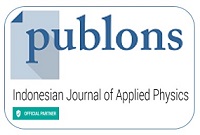Identification Sub-Surface Structure and Sediment Depth Estimation at the Proposed Indonesian New Capital City
Abstract
In this study, we employ high-resolution GGMplus gravity satellite data and three-dimensional geological modeling to ascertain sediment thickness and subterranean structures in East Kalimantan, designated as Indonesia's prospective capital. The region's sedimentary basins, specifically the Kutai Basin with up to 14 kilometers of Tertiary sedimentary rocks, are pivotal in assessing seismic risk due to their potential to amplify seismic activity. Through Fourier transformation and power spectrum analysis, we discern the Simple Bouguer Anomaly (SBA) across the region, revealing an inverse relationship between SBA values ranging from -5 mGal to 145 mGal and topographical elevation. The Mangkalihat Peninsula showcases pronounced gravity anomalies corresponding to a complex geological matrix, including a carbonate platform and an extension of the Palukoro Fault system. The three-dimensional inversion modeling, across a 29,000 meters by 27,000 meters grid, identifies varying rock densities from 2.3 g/cm³ to 2.65 g/cm³, and delineates predominant rock types such as igneous granite, claystone, limestone, and sandstone. This is further validated by resistivity measurements, aligning with geological maps. The average regional depth estimates for sediment layers are -15274.93 meters for North-South transects and -13409.25 meters for West-East transects, with residual depth estimates suggesting sediment thickness up to -1988 meters. These granular insights enhance the geological model of East Kalimantan, providing a nuanced understanding of its geophysical framework and informing the developmental blueprint for Indonesia's future capital city.
Keywords
Full Text:
PDFReferences
[1] A. Kurniadi, “Pemilihan Ibukota Negara Republik Indonesia Baru Berdasarkan Tingkat Kebencanaan,” Jurnal Manajemen Bencana (JMB), vol. 5, no. 2, pp. 1–12, 2019, doi: 10.33172/jmb.v5i2.458.
[2] H. K. Rahmat, I. D. K. K. Widana, A. S. H. Basri, and Z. Musyrifin, “Analysis of potential disaster in the new capital of indonesia and its mitigation efforts: A qualitative approach,” Disaster Advances, vol. 14, no. 3, pp. 40–43, 2021.
[3] R. Ramadhan et al., “Trends in rainfall and hydrometeorological disasters in new capital city of Indonesia from long-term satellite-based precipitation products,” Remote Sens Appl, vol. 28, p. 100827, 2022, doi: https://doi.org/10.1016/j.rsase.2022.100827.
[4] M. K. Zaki, K. Noda, K. Ito, Komariah, and D. P. Ariyanto, “Long-term trends of diurnal rainfall and hydro-meteorological disaster in the new capital city of Indonesia,” in IOP Conference Series: Earth and Environmental Science, IOP Publishing Ltd, Apr. 2021. doi: 10.1088/1755-1315/724/1/012046.
[5] R. Hall and G. Nichols, “Cenozoic sedimentation and tectonics in Borneo: Climatic influences on orogenesis,” Geol Soc Spec Publ, vol. 191, pp. 5–22, 2002, doi: 10.1144/GSL.SP.2002.191.01.02.
[6] A. H. Satyana, D. Nugroho, and I. Surantoko, “Tectonic controls on the hydrocarbon habitats of the Barito, Kutei, and Tarakan Basins, Eastern Kalimantan, Indonesia: Major dissimilarities in adjoining basins,” J Asian Earth Sci, vol. 17, no. 1–2, pp. 99–122, 1999, doi: 10.1016/S0743-9547(98)00059-2.
[7] Baharuddin, “Petrologi dan Geokimia Batuan Gunung Api Tersier Jelai di Daerah Malinau, Kalimantan Timur: Implikasi tektoniknya,” Jsdg, vol. 21, no. 4, pp. 203–211, 2011.
[8] M. A. Denolle, H. Miyake, S. Nakagawa, N. Hirata, and G. C. Beroza, “Long-period seismic amplification in the Kanto Basin from the ambient seismic field,” Geophys Res Lett, vol. 41, no. 7, pp. 2319–2325, 2014, doi: 10.1002/2014GL059425.
[9] E. A. Wirth et al., “Source-Dependent Amplification of Earthquake Ground Motions in Deep Sedimentary Basins,” Geophys Res Lett, vol. 46, no. 12, pp. 6443–6450, 2019, doi: 10.1029/2019GL082474.
[10] T. R. Walter et al., “The 26 May 2006 magnitude 6.4 Yogyakarta earthquake south of Mt. Merapi volcano: Did lahar deposits amplify ground shaking and thus lead to the disaster?,” Geochemistry, Geophysics, Geosystems, vol. 9, no. 5, pp. 1–9, 2008, doi: 10.1029/2007GC001810.
[11] B. Tian, Y. Du, Z. You, and R. Zhang, “Measuring the sediment thickness in urban areas using revised H/V spectral ratio method,” Eng Geol, vol. 260, Oct. 2019, doi: 10.1016/j.enggeo.2019.105223.
[12] S. Bahri, W. Suryanto, and D. Ngadmanto, “Sediment and crustal structure beneath East Kalimantan and East Java, Indonesia from receiver function,” in Journal of Physics: Conference Series, IOP Publishing Ltd, Mar. 2021. doi: 10.1088/1742-6596/1825/1/012014.
[13] A. Mawadah et al., “Preliminary result of dominant frequency and seismic amplification in Penajam Paser Utara and its surrounding regions using the HVSR method,” in IOP Conference Series: Earth and Environmental Science, Institute of Physics, 2023. doi: 10.1088/1755-1315/1245/1/012011.
[14] P. Ariyanto et al., “A preliminary results: study of crustal thickness in eastern part of Borneo, Indonesia from teleseismic receiver function analysis,” E3S Web of Conferences, vol. 464, p. 14003, 2023, doi: 10.1051/e3sconf/202346414003.
[15] B. G. Dewanto, R. Margiono, Y. A. Segoro, E. Pramesthi, and A. K. Maimuna, “The importance of gravity data for estimating and identifying the sediment thickness of subsurface structure around Majene Sulawesi Barat,” in AIP Conference Proceedings, American Institute of Physics Inc., Feb. 2023. doi: 10.1063/5.0115361.
[16] H. Zakariya, R. Margiono, A. Novitri, and A. Pevriadi, “Identifikasi Anomali Gravitasi Di Wilayah Sulawesi Tenggara Berdasarkan Data Gravitasi GGMplus,” PROGRESS : Jurnal Geofisika, vol. 1, no. 1 SE-Articles, pp. 63–68, Jun. 2022, [Online]. Available: https://stmkg.balai2bmkg.id/index.php/pjg/article/view/24
[17] A. K. Maimuna, E. A. Pramesthi, Y. A. Segoro, and ..., “Analisis Anomali Gaya Berat Menggunakan Metode SVD dan Pemodelan 3D (Studi Kasus Gempa di Kepulauan Togean, Kabupaten Tojo Una-Una, Sulawesi …,” Jurnal Geofisika, vol. 19, no. 01, pp. 17–23, 2021, [Online]. Available: https://178.128.59.82/index.php/jurnal-geofisika/article/view/466
[18] R. Margiono, A. Novitri, A. Pevriadi, and H. Zakariya, “Analisis Data Gravitasi Untuk Identifikasi Sesar Lokal Penyebab Gempabumi Di Wilayah Barat Daya Sumba Indonesia,” Jurnal Meteorologi dan Geofisika, vol. 22, no. 2, pp. 67–73, 2021, [Online]. Available: http://puslitbang.bmkg.go.id/jmg/index.php/jmg/article/view/824
[19] G. Florio, “The Estimation of Depth to Basement Under Sedimentary Basins from Gravity Data: Review of Approaches and the ITRESC Method, with an Application to the Yucca Flat Basin (Nevada),” Sep. 01, 2020, Springer. doi: 10.1007/s10712-020-09601-9.
[20] A. Novitri, R. Margiono, A. Pevriadi, H. Zakariya, and Y. A. Segoro, “Modeling Of Three-Dimensional Subsurface Structures Based On Gravity Anomaly In Southwest Sumba Indonesia,” Indonesian Physical Review, vol. 8, no. 1, pp. 253–267, Jan. 2025, doi: 10.29303/ipr.v8i1.388.
[21] C. Hirt, S. Claessens, T. Fecher, M. Kuhn, R. Pail, and M. Rexer, “New ultrahigh-resolution picture of Earth’s gravity field,” Geophys Res Lett, vol. 40, no. 16, pp. 4279–4283, 2013, doi: 10.1002/grl.50838.
[22] C. Hirt, M. Kuhn, S. Claessens, R. Pail, K. Seitz, and T. Gruber, “Study of the Earth’s short-scale gravity field using the ERTM2160 gravity model,” Comput Geosci, vol. 73, pp. 71–80, 2014, doi: 10.1016/j.cageo.2014.09.001.
[23] D. S. Parasnis, Principles of Applied Geophysics, Fourth. Springer Dordrecht, 1986. doi: https://doi.org/10.1007/978-94-009-4113-7.
[24] M. A. Oliver and R. Webster, “Kriging: A method of interpolation for geographical information systems,” International Journal of Geographical Information Systems, vol. 4, no. 3, pp. 313–332, 1990, doi: 10.1080/02693799008941549.
[25] R. J. Blakely, Potential Theory in Gravity and Magnetic Applications. Cambridge University Press, 1995.
[26] R. K. Verma, “Gravity Field and Isostasy in the Himalayas,” in Gravity Field, Seismicity and Tectonics of the Indian Peninsula and the Himalayas, R. K. Verma, Ed., Dordrecht: Springer Netherlands, 1985, pp. 127–145. doi: 10.1007/978-94-009-5259-1_9.
[27] Pusat Studi Gempa Nasional (Indonesia) and Pusat Penelitian dan Pengembangan Perumahan dan Permukiman (Indonesia), Peta sumber dan bahaya gempa Indonesia tahun 2017. 2017.
[28] G. P. Allen, Sedimentation in the modern and Miocene Mahakam delta. Jakarta, Indonesia : Indonesian Petroleum Association, 1998., 1998. [Online]. Available: https://search.library.wisc.edu/catalog/999935123202121
[29] S. J. Moss and J. L. C. Chambers, “Tertiary facies architecture in the Kutai Basin, Kalimantan, Indonesia,” J Asian Earth Sci, vol. 17, no. 1, pp. 157–181, 1999, doi: https://doi.org/10.1016/S0743-9547(98)00035-X.
[30] T. R. LaFehr and M. N. Nabighian, Fundamentals of Gravity Exploration. 2012. doi: 10.1190/1.9781560803058.
[31] W. M. Telford, L. P. Geldart, and R. E. Sheriff, “Applied geophysics,” 1990. doi: 10.1038/127783a0.
[32] S. R. Alzahra, D. Taryana, and F. Masitoh, “Identifikasi lapisan akuifer Kawasan Dataran Suko Mulyo, Desa Suko Mulyo, Kecamatan Sepaku, Kabupaten Penajam Paser Utara, Kalimantan Timur,” Jurnal Integrasi dan Harmoni Inovatif Ilmu-Ilmu Sosial (JIHI3S), vol. 1, no. 11, pp. 1239–1256, Nov. 2021, doi: 10.17977/um063v1i11p1239-1256.
[33] C. Hirt, S. Claessens, T. Fecher, M. Kuhn, R. Pail, and M. Rexer, “New ultrahigh-resolution picture of Earth’s gravity field,” Geophys Res Lett, vol. 40, no. 16, pp. 4279–4283, 2013, doi: 10.1002/grl.50838.
[34] P. Wessel et al., “The Generic Mapping Tools Version 6,” Geochemistry, Geophysics, Geosystems, vol. 20, no. 11, pp. 5556–5564, 2019, doi: https://doi.org/10.1029/2019GC008515Refbacks
- There are currently no refbacks.
















